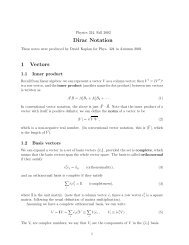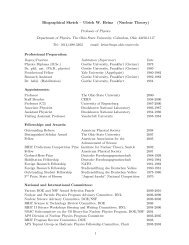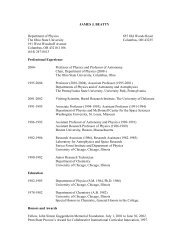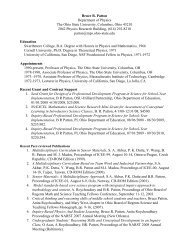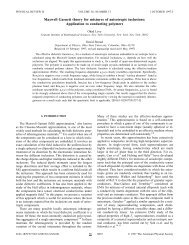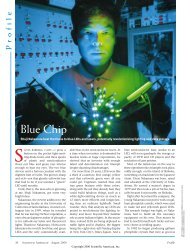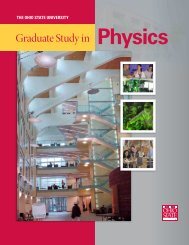Brasil Final Report - Department of Physics - The Ohio State University
Brasil Final Report - Department of Physics - The Ohio State University
Brasil Final Report - Department of Physics - The Ohio State University
You also want an ePaper? Increase the reach of your titles
YUMPU automatically turns print PDFs into web optimized ePapers that Google loves.
51<br />
CHANGES IN UNDERGRADUATE PHYSICS IN THE UNITED STATES<br />
Ruth H. Howes<br />
Ball <strong>State</strong> <strong>University</strong><br />
<strong>Department</strong> <strong>of</strong> <strong>Physics</strong> and Astronomy<br />
47306 – Muncie – IN USA<br />
rhowes@bsu.edu<br />
Undergraduate physics departments in the United <strong>State</strong>s operate in a rapidly changing<br />
environment over which individual departments have little control. This new environment presents<br />
both challenges and opportunities. <strong>Department</strong>s that respond creatively and constructively to these<br />
changes will thrive in the 21st century. Those that continue business as usual will decline just as<br />
classics departments declined when Latin was no longer the language <strong>of</strong> educated men and women.<br />
<strong>The</strong> number <strong>of</strong> bachelor's degrees in physics has plummeted to pre-Sputnik levels in spite <strong>of</strong><br />
the doubling <strong>of</strong> the total number <strong>of</strong> bachelor's degrees granted. <strong>The</strong>re are 762 colleges and<br />
universities in the U.S. which <strong>of</strong>fer bachelor's degrees in physics. Sixty seven percent <strong>of</strong> them <strong>of</strong>fer<br />
only the first degree; nine percent <strong>of</strong>fer a master's degree in physics; and twenty four percent <strong>of</strong>fer<br />
the Ph.D. In 1998, the median number <strong>of</strong> undergraduate physics bachelor's granted by Ph.D.<br />
institutions was seven, and for bachelor's only institutions, it was three. Sixty-three percent <strong>of</strong> BSgranting<br />
institutions and twenty-six percent <strong>of</strong> Ph.D.-granting institutions produced fewer than<br />
three undergraduate physics graduates, and many produced none at all. Deans have begun to notice<br />
that many physics departments have more faculty than undergraduate majors.<br />
<strong>Physics</strong> departments have never produced large numbers <strong>of</strong> majors compared to departments<br />
like journalism or history. However, other disciplines, notably engineering and medicine, require<br />
physics courses, and most physics departments teach large numbers <strong>of</strong> students from other majors.<br />
Enrollments in these service courses are currently holding, however, new accreditation standards for<br />
engineering schools are being implemented. <strong>The</strong>se new standards base accreditation not on specific<br />
courses required <strong>of</strong> students but on the performance <strong>of</strong> students who graduate. Thus engineering<br />
students still need a good understanding <strong>of</strong> basic physics, but they are not required to enroll in a<br />
year <strong>of</strong> calculus-based physics taught in a physics department. Engineering schools are demanding<br />
more responsive physics courses for their students with the threat <strong>of</strong> teaching physics themselves.<br />
In addition to service teaching, large physics departments with few undergraduate majors<br />
have survived because they brought in large research grants with associated indirect costs that could<br />
support faculty and university infrastructure. If you remove the National Institutes <strong>of</strong> Health from<br />
consideration, funding for non-defense research and development in the U.S. has declined by six<br />
percent over the last six years. <strong>Physics</strong> has been particularly hard hit since many basic projects<br />
were funded by the military where funding for basic research has also experienced cuts. More and<br />
more physics faculty members are competing for less federal money.<br />
<strong>The</strong>se symptoms have forced physics departments to consider the environment in which<br />
they operate today. First, physics, as a discipline is changing. Just after World War II, physics<br />
was the nucleus about which other sciences orbited. Today, it is one <strong>of</strong> the atoms making up the<br />
complex molecule <strong>of</strong> interrelated scientific disciplines. Increasingly, state-<strong>of</strong>-the-art physics<br />
research requires large teams from several institutions. Many physicists travel to large user facilities<br />
instead <strong>of</strong> working in university laboratories.




